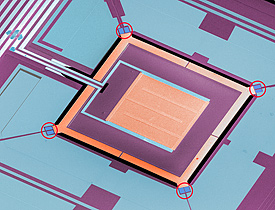Home > Press > NIST Micro Sensor and Micro Fridge Make Cool Pair
 |
| Colorized micrograph of a NIST chip combining four microrefrigerators (circled in red) with a superconducting sensor (large orange square in the middle). The self-cooling chip could be used for applications ranging from detailed X-ray analysis of semiconductors to detection of microwave signals in deep space.
Credit: N. Miller, K. Talbott NIST |
Abstract:
Researchers at the National Institute of Standards and Technology (NIST) have combined two tiny but powerful NIST inventions on a single microchip, a cryogenic sensor and a microrefrigerator. The combination offers the possibility of cheaper, simpler and faster precision analysis of materials such as semiconductors and stardust.
NIST Micro Sensor and Micro Fridge Make Cool Pair
GAITHERSBURG, MD | Posted on April 15th, 2008As described in an upcoming issue of Applied Physics Letters,* the NIST team combined a transition-edge sensor (TES), a superconducting thin film that identifies X-ray signatures far more precisely than any other device, with a solid-state refrigerator based on a sandwich of a normal metal, an insulator and a superconductor. The combo chip, a square about a quarter inch on a side, achieved the first cooling of a fully functional detector (or any useful device) with a microrefrigerator. The paper also reports the greatest temperature reduction in a separate object by microrefrigerators: a temperature drop of 110 millikelvins (mK), or about a tenth of a degree Celsius.
TES sensors are most sensitive at about 100 mK (a tenth of a degree Celsius above absolute zero). However, these ultralow temperatures are usually reached only by bulky, complex refrigerators. Because the NIST chip can provide some of its own cooling, it can be combined easily with a much simpler refrigerator that starts at room temperature and cools down to about 300 mK, says lead scientist Joel Ullom. In this setup, the chip would provide the second stage of cooling from 300mK down to the operating temperature (100 mK).
One promising application is cheaper, simpler semiconductor defect analysis using X-rays. A small company is already commercializing an earlier version of TES technology for this purpose. In another application, astronomical telescopes are increasingly using TES arrays to take pictures of the early universe at millimeter wavelengths. Use of the NIST chips would lower the temperature and increase the speed at which these images could be made, Ullom says.
For background on how TESs and microrefrigerators work, see "Copper Ridges Nearly Double X-ray Sensor Performance" (Tech Beat, Nov. 17, 2005), and "Chip-scale Refrigerators Cool Bulk Objects" (Tech Beat, April 21, 2005).
The work was supported in part by the National Aeronautics and Space Administration.
* N.A. Miller, G.C. O'Neil, J.A. Beall, G.C. Hilton, K.D. Irwin, D.R. Schmidt, L.R. Vale and J.N. Ullom. High resolution X-ray transition-edge sensor cooled by tunnel junction refrigerators. Forthcoming in Applied Physics Letters.
Media Contact: Laura Ost,
####
About NIST
The National Institute of Standards and Technology (NIST) is a non-regulatory agency of the U.S. Department of Commerce. NIST promotes U.S. innovation and industrial competitiveness by advancing measurement science, standards and technology in ways that enhance economic security and improve our quality of life.
For more information, please click here
Contacts:
Laura Ost
(303) 497-4880
Copyright © NIST
If you have a comment, please Contact us.Issuers of news releases, not 7th Wave, Inc. or Nanotechnology Now, are solely responsible for the accuracy of the content.
| Related News Press |
News and information
![]() Simulating magnetization in a Heisenberg quantum spin chain April 5th, 2024
Simulating magnetization in a Heisenberg quantum spin chain April 5th, 2024
![]() NRL charters Navy’s quantum inertial navigation path to reduce drift April 5th, 2024
NRL charters Navy’s quantum inertial navigation path to reduce drift April 5th, 2024
![]() Discovery points path to flash-like memory for storing qubits: Rice find could hasten development of nonvolatile quantum memory April 5th, 2024
Discovery points path to flash-like memory for storing qubits: Rice find could hasten development of nonvolatile quantum memory April 5th, 2024
Chip Technology
![]() Discovery points path to flash-like memory for storing qubits: Rice find could hasten development of nonvolatile quantum memory April 5th, 2024
Discovery points path to flash-like memory for storing qubits: Rice find could hasten development of nonvolatile quantum memory April 5th, 2024
![]() Utilizing palladium for addressing contact issues of buried oxide thin film transistors April 5th, 2024
Utilizing palladium for addressing contact issues of buried oxide thin film transistors April 5th, 2024
![]() HKUST researchers develop new integration technique for efficient coupling of III-V and silicon February 16th, 2024
HKUST researchers develop new integration technique for efficient coupling of III-V and silicon February 16th, 2024
Discoveries
![]() Chemical reactions can scramble quantum information as well as black holes April 5th, 2024
Chemical reactions can scramble quantum information as well as black holes April 5th, 2024
![]() New micromaterial releases nanoparticles that selectively destroy cancer cells April 5th, 2024
New micromaterial releases nanoparticles that selectively destroy cancer cells April 5th, 2024
![]() Utilizing palladium for addressing contact issues of buried oxide thin film transistors April 5th, 2024
Utilizing palladium for addressing contact issues of buried oxide thin film transistors April 5th, 2024
Announcements
![]() NRL charters Navy’s quantum inertial navigation path to reduce drift April 5th, 2024
NRL charters Navy’s quantum inertial navigation path to reduce drift April 5th, 2024
![]() Discovery points path to flash-like memory for storing qubits: Rice find could hasten development of nonvolatile quantum memory April 5th, 2024
Discovery points path to flash-like memory for storing qubits: Rice find could hasten development of nonvolatile quantum memory April 5th, 2024
|
|
||
|
|
||
| The latest news from around the world, FREE | ||
|
|
||
|
|
||
| Premium Products | ||
|
|
||
|
Only the news you want to read!
Learn More |
||
|
|
||
|
Full-service, expert consulting
Learn More |
||
|
|
||








